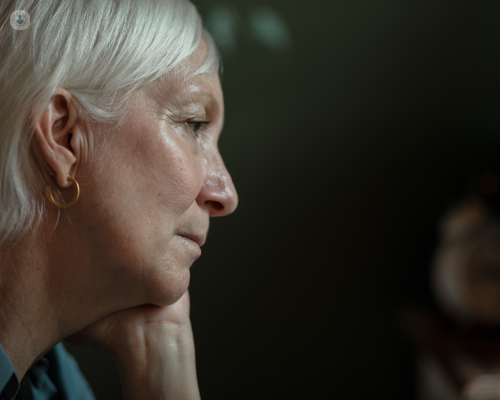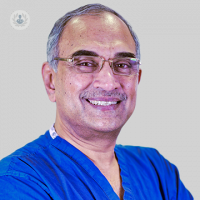Breast reconstruction surgery: Everything you need to know
Autore:
Breast reconstruction surgery is a procedure that's usually undertaken after surgery to treat and prevent breast cancer. The emotions and overwhelm that can come with diagnosis, treatment, and then the prospective removal of a breast and reconstruction after everything, can be tough.
Here to offer clarity and expert guidance about exactly what to expect from breast reconstruction surgery is highly-experienced plastic surgeon, Mr Venkat Ramakrishnan. He answers some of the most commonly-asked questions about the procedure in this informative article.

Is breast reconstruction a major surgery?
This is a very common question. It is a major surgery. No surgery is simple surgery. All surgery has to be done for a reason and it has to be done safely and properly. If you take care, in a fit adult, to perform breast reconstruction surgery - when you say major, there is never a risk to life or death, that kind of risk, because what you are doing in breast reconstruction is removing the breast, which is an organ just under the skin and we are removing fat from another place. So, it's all surface surgery, it isn't into the bowel or into the lung, or that kind of thing. So, in that way it isn't life-threatening surgery. However, any surgery has to be respected and it has to be done properly.
What are the different breast reconstruction options available?
A very simple option to start with, is, using an implant. In some patients, you have very good quality skin and it all depends on the skin that the breast surgeon can leave behind. So, I'm a breast reconstruction surgeon and there is a breast surgeon who removes the breast. At the same time, I move in and I rebuild the breast before the patient wakes up. It depends on the skin of the breast, which is left behind. If the quality is good, we can use an implant at times. If the patient is going to have radiotherapy after the operation, then we can't use implants because the implants go very hard and they need repeated operation. So, it isn't a good operation. In select patients, who don't have radiotherapy, and have very good quality skin and the breast isn't too big, then implant reconstruction is the type of reconstruction we offer.
Other than that, almost all patients who have some fatty tissue in other parts of the body, we can use that tissue to rebuild the breast. That is the flap surgery and this is the best form of reconstruction because this lasts forever. It's with the patient, it's the patient's own tissue and it's durable. It ages with the patient and if the patient puts on weight it swells and if the patient loses weight it reduces, and you don't need to do maintenance surgery like for implant surgery. These are the types of reconstructions.
Can belly fat be used for breast reconstruction?
Belly fat is the best source for breast reconstruction and there are many issues here. One is, there is usually, if the patient has had one or two pregnancies, there's enough skin and fat, and we can take and make the tummy much flatter and nicer-looking. At the same time, we can use the tissue to rebuild the breast. This is the most common form of tissue rebuild being done around the world, now.
I personally would be doing about 250 of these a year. That is the kind of volume people are doing. Another reason for this is, this is one area where we can take the fat from, at the same time as the breast surgeon doing the mastectomy. So, the patient is flat and we don't have to take it from there. If you need to take the fat from the back, you need to turn the patient over after the mastectomy. Here, it is one position so there are many advantages and yes, belly fat is a good area to make a breast from.
What is involved in recovery after breast reconstruction? Are drains used?
Almost always we'll use drains after a mastectomy and reconstruction. There will be a drain in the breast and there might be a drain in the armpit, because sometimes we clear the lymph nodes at the same time. And then, there'll be a drain in the tummy, wherever the tissue is taken from. Usually, in the first two days, all drains will be removed and the patient will be discharged from the hospital in about four days. So, that is the usual sequence.
With regards to recovery, by the time the patient leaves the hospital in four days, they'll be having a shower, they'll be walking up and down the stairs, so they'll move around the corridor. They can look after themselves and they don't need a carer to sit next to them when they go home, that kind of thing.
They won't be able to run a household and they can't care for the other people in the house, so somebody has to look after the household and the patient can usually, for the first two weeks, we recommend that the patient just looks after themselves. We allow them to go for long walks, but not get into a car and travel. Those kinds of restrictions for two weeks. After that, they can start moving about a bit more freely, going out and so on. About six weeks, almost all activities, can continue.
How much does breast reconstruction cost?
In the National Health Service, breast reconstruction is available for all patients who are having mastectomies. In the private sector, most often, the patients who come to us are insured patients, so the insurance company will pay. Sometimes, we get people from abroad, or even local people, who don't have insurance, seeking a private, self-pay model.
A breast reconstruction using abdominal tissue, that is: tummy tuck, kind of breast reconstruction, along with the mastectomy and all the lymph node clearance. It might be come between £25,000 and £27,000. That is the kind of range the hospitals have.
If you want a breast reconsruction procedure with this highly-experienced plastic surgery consultant, arrange an appointment with Mr Venkat Ramakrishnan via his Top Doctors profile.


